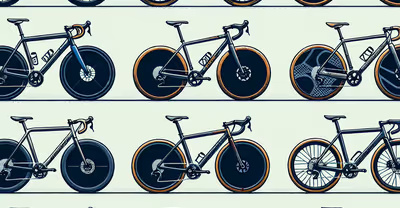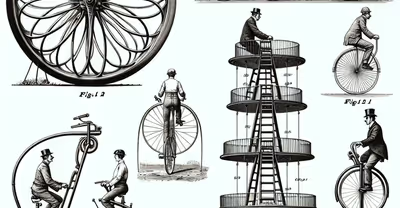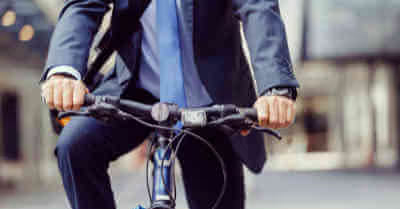
Key Takeaways
- Laws designed for cycling can be unexpectedly offbeat.
- Rules vary highly, reflecting a place's culture and safety concerns.
- A deep dive into these will offer both enlightenment and entertainment.
Ever cycled with a 15-foot flag soaring above you?
Imagine the sight!
Biking laws, as practical as they're intended to be, can sometimes venture into the realm of the truly peculiar.
Beyond the essential "stop at red lights," there's a world of unusual regulations that govern two-wheeled travelers.
Did you know some places require your bike to sport a towering flag, while others forbid a daredevil foot lift off the pedals?
Navigating these odd rules could be as challenging as a steep uphill climb!
Trust us, the diversity of these laws is as vast as the cycling trails you dream of conquering.
So, pedal on as we guide you through some of the most bizarre twists and turns of cycling legislation—a journey sure to leave you both informed and mildly amused.
Missouri, USA: Cyclists must have a fluorescent flag attached to their bicycles that is at least 15 feet high
Hey cycling enthusiast!
Ever imagine flying a flag while pedaling your bike?
Well, in Missouri, it's not just for show—it's the law!
Missouri legislators put forth a proposal that’s as eye-catching as it is tall.
If you're biking on lettered county roads, you're required to sport a fluorescent orange flag that’s no less than a whopping 15 feet off the ground.
Why such towering standards, you ask?
It’s all about safety.
The aim here is to make you stand out like a periscope on a submarine, ensuring motorists can't miss you pedaling by.
Agreeably, this takes bike visibility to new heights, quite literally!
So, what do you need if you're planning to ride through Missouri's scenic routes?
- A bicycle
- A love for the open road
- A fluorescent flag with a pole that soars to at least 15 feet high
Remember Jay Houghton's name; he's the Republican member of the Missouri House who introduced this sky-high bill.
Picture it—your flag fluttering boldly, sending a clear message: "I'm here, I'm clear, and I'm practicing safe cycling."
No doubt this rule could make for a tricky journey if there's a heavy gust of wind, or if there are low-lying bridges to contend with.
But hey, you'll be at the forefront of rural cycling trends and literally flying your cyclist colors.
So, before you gear up and head out, check your height!
In Missouri's countryside, raising the bar for cyclist safety might mean raising your flag really, really high.
Keep it fun, keep it safe, and keep it fluorescent, my pedal-pushing pals!
Mexico City, Mexico: Cyclists are prohibited from lifting their feet off the pedals while riding.
Have you ever found yourself pedaling through the bustling streets of Mexico City?
It's quite the adventure, isn't it?
But here's something you might not know: in this vibrant metropolis, cyclists are required to keep their feet on the pedals at all times while riding.
That's right, no showing off with flashy no-pedal coasting here!
You might be asking, "But why such a specific rule?" Well, it's all about safety.
Keeping your feet firmly on the pedals means you've got full control of your bike, and that's crucial in a city that's alive with activity.
- Safety First: This law helps prevent accidents caused by loss of control.
- Stay in Control: It ensures you can always act quickly to stop or maneuver.
This might seem like a quirky law, especially if you love to freewheel down a hill or stretch your legs mid-ride.
But hey, it makes a lot of sense when you think about it.
Mexico City's streets can be unpredictable, and being ready to brake or swerve in an instant is key for your safety—and for everyone else's.
Remember, it's not just about following the rules; it's about making sure you and your fellow cyclists can enjoy the ride and get home without a hitch.
So the next time you're in Mexico City, keep those feet on the pedals and enjoy the ride with confidence and control!
Baldwin Park, California, USA: It is illegal to ride a bicycle in a swimming pool.
Have you ever thought about taking your cycling routine to new depths—perhaps underwater?
In Baldwin Park, California, they've already thought of that, and they've made it clear that bicycles and swimming pools are not a good mix.
That's right, you can't ride your bike in a swimming pool in Baldwin Park.
It seems like a strange thing to regulate, doesn't it?
But there’s method to the madness.
The reason behind this unusual rule is practical—it’s all about preventing damage and keeping things safe.
Imagine the scratches a bike could leave on the pool's lining or the chaos if everyone started peddling in the deep end!
Plus, safety is a big concern—water and bikes are not exactly known for being the best of friends.
- Safety: Keeping pools free from bicycles means everyone can swim without fear of an unexpected obstacle.
- Pool Damage: Bikes can be tough on surfaces not designed to handle them, like the delicate liner of a swimming pool.
So, if you find yourself in Baldwin Park with an urge to combine swimming and cycling, put those thoughts aside.
The local ordinance has got that base covered, and it's for a good reason.
Keep your bike on dry land, and stick to making waves with your swimming—not with rule-breaking.
After all, who wants to be the one explaining why there's a bicycle lodged in the deep end?
Not you, right?
Keep it wheel, I mean real, and enjoy your swim without the extra gear!
Grafton, Illinois, USA: Cyclists are not allowed to ride "recklessly"
Hey bike lovers, have you ever pedaled through Grafton, Illinois?
If you plan to, remember, they've put the brakes on reckless riding.
Ever wonder what counts as "reckless"?
Well, it's not just about how fast you're going!
In Grafton, "reckless" is a bit of a puzzle – it basically means don't endanger others.
If your cycling stunts are more circus act than commuter ride, you might need to tone it down.
- Stay alert: Keep those eyes peeled for anything that could cause a tumble or a tangle.
- Respect others: Whether they're on foot or also on wheels, give them space.
- Obey the rules: Stop signs and lights aren't just for decoration!
You're sharing the road, not starring in a stunt show.
So, if the thought crossed your mind to wheelie past a crowd, think again.
Your bike's not a bucking bronco!
Let's keep it fun and friendly out there—safety is the name of the game.
And remember, just because you're not tearing up the tarmac doesn't mean you can't enjoy the ride.
So, what's the secret to being a cool cyclist in Grafton?
It's simple:
- Glide with grace.
- Brake before you break (the law, that is).
- Smile and cycle on.
Stay safe, and let the good times roll... sensibly, of course!
United Kingdom: It is Illegal to Cycle "Furiously"
Hey, did you know that in the UK, there's a quirky law on the books that could land you in a bit of a tangle if you're too pedal-happy?
That's right, while it might sound a bit humorous, it's actually illegal to cycle "furiously." What does that mean, you ask?
Let's break it down!
- The Law: Under UK legislation, specifically the Offences Against the Person Act 1861, furiously pedaling your cycle is deemed unlawful. It's all about keeping streets safe and preventing dangerously speedy cyclists from causing harm.
- The Speed: Now, the law doesn't exactly put a speedometer limit on what 'furiously' equates to. But think of it this way: if you're zooming past cars and causing pedestrians to jump out of the way, you're probably overdoing it.
- The Consequence: Get caught breaking this rule, and you could be facing more than just disapproving looks. Cyclists found guilty of riding at excessive speeds can be fined or even face imprisonment!
Isn't it fascinating to think that a law from the 1800s is still in effect today?
It goes to show, some rules stand the test of time.
So next time you're out and about on your bike, remember: it's not just about wearing your helmet and ringing that bell.
Keep your speed in check and cycle sensibly to ensure everyone's safety - plus, who really wants to explain a "cycling furiously" fine to their friends?
Stay safe, and keep it wheel!
Connecticut, USA: Cyclists are not allowed to exceed 65 mph
Have you ever thought about how fast you can go on two wheels?
Well, if you find yourself pedaling furiously in Connecticut, you may want to tap the brakes before hitting 65 mph.
Yep, that's right—you're not allowed to exceed that speed on a bicycle in the state.
Why 65 mph, you ask?
It's a way to keep things safe on the roads, both for you and for cars.
Just like motor vehicles, cyclists have to obey speed limits to ensure everyone gets where they're going without any, let's say, 'unexpected pit stops'.
- Safety First: The law is there to remind us that while feeling the wind in your hair is great, safety always comes first.
- Speed Limit Compliance: Just like cars, cyclists are part of the traffic ecosystem and need to follow speed-related rules.
Considering the physics of cycling, reaching 65 mph on flat ground is a feat that would typically require you to be part superhero.
Most cyclists average between 10-20 mph, maybe pushing 30 mph when going all out downhill with a tailwind cheering them on.
So, chances are, you won't need to worry about breaking this particular speed limit.
But, it's important to note that just because you can go that fast, doesn't mean you should.
Remember, laws are in place for a reason, and your safety is the top priority.
Keep an eye on your speedometer (if you've got one), enjoy the ride, and let's keep our cycling adventures within the legal speed thrill.
Happy and safe cycling!
San Francisco, California, USA: Bicyclists Yield to Pedestrians and Sidewalk Restrictions for Teens
Hey there, San Francisco cyclist!
Did you know that in our vibrant city, you're like a knight on a noble steed when on the road?
But there's a catch: pedestrians are the kings and queens, and you've got to yield to them on the sidewalks.
That's right—safety first!
Pedestrians have the right-of-way, and it's on you to ensure they can strut across those crosswalks worry-free.
Now, let's talk age—it matters!
If you're over 13 years old, the sidewalk is a no-go zone for your bike.
Why, you ask?
Well, it's simple.
As we grow up, we ride faster, and sidewalks can become a bustling hub of folks walking dogs, window-shopping, or kids playing hopscotch.
Just imagine the chaos if everyone decided to zip through on their bikes!
So, if you're a teen or older, the road is your domain.
This isn't to spoil your fun but to keep everyone safe, including you.
Embrace the street, and don't forget—those iconic bike lanes are your best friend.
Remember, sharing is caring.
On San Francisco's streets, we all have a role to play in keeping the vibe chill and the air safe to breathe.
So next time you hop on your bike, give a friendly nod to the pedestrians and cruise with pride on the road, because you're rolling through one of the most bike-friendly cities in the world, and that's pretty cool, isn't it?
Keep the vibes high and the rides smooth, and always stick to the rules that keep our sidewalks serene and our streets spectacular!
Japan: Cyclists are prohibited from carrying an umbrella while riding
Have you ever found yourself cycling and caught in the rain?
In Japan, reaching for an umbrella is a no-go while on your bike.
Why, you might ask?
It's all about keeping your hands on the handlebars to ensure you don't lose control and find yourself in a slippery situation.
- The Rule: Holding an umbrella while riding is technically banned.
- The Reason: Safety comes first – cycling one-handed can lead to accidents.
But let's be real, on a rainy day in Japan, it wouldn't be shocking to spot a cyclist with one hand steering and the other bravely battling the elements with an umbrella.
Despite the clear-cut rule:
- Cyclists should not hold an umbrella while moving.
- Violation can attract fines and is enforced to maintain safety.
Japan's streets often tell a different story, with many daring to break the norm.
However, keep in mind that the Japanese law is quite strict when it comes to road safety, and flouting this particular regulation could result in more than just a few side glances from fellow cyclists.
Remember, it's all fun and games until someone ends up with more than just wet socks.
So, the next time you're pedaling in Japan, maybe invest in a good raincoat or a bike with an umbrella holder.
Stay dry, stay safe, and keep those hands where they belong – on your handlebars!
Australia: In some states, it is illegal to ride a bike without wearing a helmet, even if you're an adult.
Guess what?
Down under in Australia, you can't just hop on your bike and pedal away without thinking about your noggin.
That's right, in several Aussie states, adults are required by law to wear helmets while cycling.
Bet you're wondering what that 'no helmet' decision might cost you, huh?
Let's break it down:
- South Australia: Forget your helmet at home? You're looking at a $113 hit to your wallet, plus don't forget the victims of crime levy of $92, tallying up to $205. Ouch!
- Tasmania: Not strapping on that helmet could see you parting with a whopping $344.
- Victoria: Caught without a helmet here? That's $227 you'll be saying goodbye to.
- Australian Capital Territory: All cycling fines, helmet-related or not, come in at a flat rate of $146.
And don't think you can skirt around Melbourne’s bike paths without a helmet.
Getting caught will lighten your pocket by $207.
Now, I'm not just here to scare you into wearing a helmet with these numbers.
But let's be real, nobody wants to shell out that kind of dough for something totally preventable.
Plus, it's all about keeping that beautiful brain of yours safe!
So next time you're gearing up for a ride, remember your trusty helmet.
It's not just a fashion statement — it's your ticket to avoiding a hefty fine and staying on the right side of the law.
Go on, wear it proudly, and ride on!
Portugal: Cyclists are required to ride on the right side of the road and as close to the right edge as possible
Hey there, cycling enthusiast!
If you're planning to pedal through Portugal, there's an important rule you should know about.
When you're cruising on your bike, you've got to stick to the right side of the road, hugging the right edge as closely as you can.
Why's that?
Well, it keeps you safe and sound, while also making sure other vehicles can easily pass.
Let's break it down:
- Always stay on the right: Whether you're admiring the stunning coastline or navigating through bustling city streets, keep to the right like it's your best friend.
- Give the edge some love: Keep a respectful distance from the sidewalk and curbs, because nobody likes an unexpected tumble!
Now, here’s a twist: while enjoying your solo ride is great, what happens when you're with your cycling squad?
The rule of thumb is to ride single file.
Yes, even if that means resisting the urge to chat side-by-side with your buddy.
Only break formation when you're overtaking another cyclist—and always do so with care.
But wait, there are some numbers to keep in mind too!
If you're caught taking liberties with these rules, fines can range from €30 to €150 for cyclists.
That's half the amount drivers pay, but let's keep our wallets happy by staying within the lines, shall we?
Remember, these laws are in place to keep everyone safe, so embrace them and enjoy your ride.
Happy cycling! 🚴♀️🚴♂️




















































































































































































































































































































































































































































































































































































































































































































































.avif)
